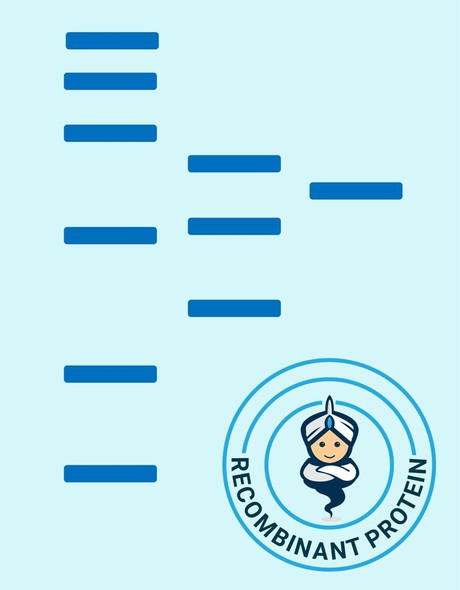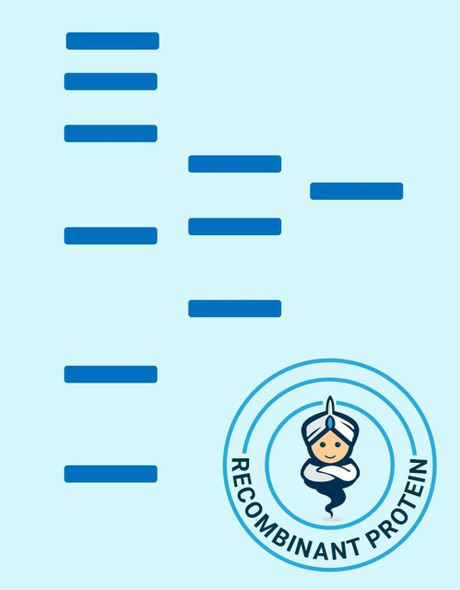Description
| Product Name: | Human GP2 Recombinant Protein |
| Product Code: | RPPB3631 |
| Size: | 10µg |
| Species: | Human |
| Target: | GP2 |
| Synonyms: | Glycoprotein 2 (zymogen granule membrane), Pancreatic zymogen granule membrane protein GP-2, ZAP75, DKFZp779K0533. |
| Source: | Sf9 Insect cells |
| Formulation: | GP2 solution is supplied in 16mM HEPES buffer pH-7.5, 80mM NaCl and 20% glycerol. |
| Stability: | Store at 4°C if entire vial will be used within 2-4 weeks. Store, frozen at -20°C for longer periods of time.�Avoid multiple freeze-thaw cycles. |
| Purity: | Greater than 95% as determined by SDS-PAGE. |
Crohn's Disease (CD), which is very common in Caucasians, is an inflammatory bowel diseases (IBD). Mucosal inflammation in CD seems to arise when dysregulation of the immune system breaks the balance between tolerance to commensal microbiota or food-derived antigens and immunity to pathogens. The autoimmune mechanisms takes part in the development of CD, and exocrine pancreas autoantibodies (PAB) are disease-specific in CD patients. It was established not too long ago that glycoprotein 2 (GP2) is the major autoantigenic mark recognized by CD-specific PAB. Furthermore to IgG and IgM PAB isotypes, IgA pancreatic autoantibodies were also identified in CD patients. GP2 is an extremely glycosylated 78 kDa protein with N-linked carbohydrates. It is responsible for up to 40% of all zymogen granule (ZG) membrane proteins in pancreatic acinar cells and is linked to the ZG membrane via a glycosyl phosphoinositol (GPI) anchor.
GP2 is a cDNA coding for the free form of the human pancreatic secretory granule membrane major glycoprotein / GP2 having a molecular mass of 68,000 Dalton (protein component excluding glycosylation; observed molecular weight approx. 68 kDa) pH 5.4. GP2 protein is fused to a deca-histidine purification tag.
| NCBI Summary: | This gene encodes an integral membrane protein that is secreted from intracellular zymogen granules and associates with the plasma membrane via glycosylphosphatidylinositol (GPI) linkage. The encoded protein binds pathogens such as enterobacteria, thereby playing an important role in the innate immune response. The C-terminus of this protein is related to the C-terminus of the protein encoded by the neighboring gene, uromodulin (UMOD). Alternative splicing results in multiple transcript variants. [provided by RefSeq, Jan 2015] |
| UniProt Code: | P55259 |
| NCBI GenInfo Identifier: | 215274153 |
| NCBI Gene ID: | 2813 |
| NCBI Accession: | P55259.3 |
| UniProt Secondary Accession: | P55259,Q13338, Q9UIF1, A6NFM9, A6NJA8, |
| UniProt Related Accession: | P55259 |
| Molecular Weight: | Calculated MW: 43kDa/59kDaObserved MW: 59kDa |
| NCBI Full Name: | Pancreatic secretory granule membrane major glycoprotein GP2 |
| NCBI Synonym Full Names: | glycoprotein 2 |
| NCBI Official Symbol: | GP2�� |
| NCBI Official Synonym Symbols: | ZAP75�� |
| NCBI Protein Information: | pancreatic secretory granule membrane major glycoprotein GP2 |
| UniProt Protein Name: | Pancreatic secretory granule membrane major glycoprotein GP2 |
| UniProt Synonym Protein Names: | Pancreatic zymogen granule membrane protein GP-2; ZAP75 |
| Protein Family: | Polygalacturonase |
| UniProt Gene Name: | GP2�� |






